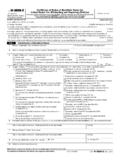Transcription of RESP Questions and Answers Guide Table of …
1 1 RESP Questions and Answers GuideTable of ContentsDefinition of Terms2 What is an RESP?5 Types of Plans6 Contributions7 Subscribers9 Beneficiaries10 Investments12 Educational Assistance Payments13 Accumulated Income Payments15 Canada Education Savings Grant17 Closing an RESP20 The SMI RESP212 Definition of TermsAccumulated Income Payment (AIP)"Accumulated income payments" are payments to the subscriber out of an RESP s investmentearnings, including earnings on the Grant. An AIP can only be made if the plan has been inexistence for 10 years; all beneficiaries have reached age 21; no beneficiary is attending school;and the subscriber is resident of Canada.
2 These conditions may be waived under certaincircumstances ( deceased or mentally impaired beneficiary). AIPs are taxable income for thesubscriber and are subject to an additional 20 percent deferral tax, unless transferred to an ContributionsContributions made to an RESP after 1997 in respect of which a CESG has been or will be "Beneficiary" under a Registered Education Savings Plan is an individual named by thesubscriber who will receive Educational Assistance Payments if the individual qualifies for thesepayments under the terms of the Education Savings Grant (CESG)
3 Canada Education Savings Grant" means a grant paid by Human Resources DevelopmentCanada to the RESP trustee for deposit on behalf of the Assistance Payment (EAP)An "Educational Assistance Payment" means any amount paid or payable under an RESP to orfor an individual (called the beneficiary) to assist with the individual's education at the post-secondary school level. These amounts do not include refunds of contributions made to thesubscriber of the Savings PlanAccording to the Income Tax Act, section (1), an "education savings plan" means a contractentered into at any time between an individual (in this section referred to as a "subscriber") and aperson or organization (in this section referred to as a promoter")
4 Under which, the promoteragrees to pay or cause to be paid educational assistance payments to or for one or Contribution RoomBeginning with 1998, each child under age 18 who is resident in Canada accumulates "grantcontribution room" at a rate of $400/yr to age 17 (includes year child turns 17). The grant roomaccumulates whether or not the child is currently an RESP beneficiary and any unusedcontribution room is carried RESP ( Pooled Plans)Group plans are operated on a pooling principle where the beneficiary named under a contract bya subscriber will receive Educational Assistance Payments when enrolled in a qualifyingprogram, but if the beneficiary fails to qualify for payment, the earnings are distributed amongother beneficiaries of the same age who do Resource Development Canada.
5 Government agency that runs the CESG portion of theRESP. RESPs are under the jurisdiction of Revenue Educational InstitutionA "Post-secondary educational institution" can be any of the following:a) A university, college, or other educational institution in Canada that has been designated forpurposes of the Canada Student Loans Act or the Canada Student Financial Assistance Act, or isrecognized for purposes of the Quebec Student Loans and Scholarships ) An educational institution in Canada certified by the Minister of Human ResourcesDevelopment to be providing courses, other than courses designed for university credit, that givea person occupational skills or improve a person s occupational )
6 A university, college or other educational institution outside Canada that provides courses at apost-secondary school level, provided the beneficiary is enrolled in a course that runs at least 13consecutive Promoter can be any person/organization offering a Registered Education Savings Plan tothe Education Savings Plan (RESP)A "Registered Education Savings Plan" is a contract between a subscriber and an RESP promoterunder which the subscriber makes contributions on behalf of a beneficiary and the promoteragrees to make Educational Assistance Payments to the beneficiary.
7 The RESP is registeredunder the Income Tax ( contributor)A person who enters into an RESP contract with the promoter is the subscriber. The subscriberagrees to contribute to the contract on behalf of an individual named under t the plan as : If the plan permits, spouses can be joint subscribers. The subscriber must be a , a corporation, trust, church, or charity cannot be a Income Tax Act requires RESP funds to be held by a corporation licensed to be a trustee is engaged by the promoter and can be the promoter itself. The CESG will beprovided directly to the plan ContributionsContributions made to an RESP in respect of which no CESG has been or will be is an RESP?
8 An RESP is a contract between an individual (the subscriber) and a promoter ( ). The subscriber makes contributions, on behalf of a beneficiary(s), for thepurpose of making educational assistance payments to the does it work? Contributions are limited to $4,000 per year, per beneficiary to a lifetime maximum of$42,000 per beneficiary. Contributions may be made to the plan up to tend of the 21st year the plan is opened. Forexample, if a plan is opened in May, 1999 the last contribution date is December 31, 2020. The government will provide a grant of 20% on the first $2,000 contributed each year, foreach beneficiary aged 18 or less.
9 There are special conditions that must be met forbeneficiaries aged 16 and 17 to receive a grant (see Q and A below for details). Once a beneficiary has begun attending an approved post-secondary educational institution,they can begin to withdraw the income earned from the contributions made to the plan. Theseare known as Educational Assistance Payments (EAPs). The principal (contributions) may be withdrawn by the subscriber at any time, but may resultin a repayment of the grant to the government. The plan must be closed by December 31st of the 25th year after being opened, an RESP opened in May, 2000 must be terminated by December 31st, of PlansWhat is the difference between family and individual plans?
10 An individual plan permits only one beneficiary per plan. The beneficiary can be anyone,including the family plan permits more than one beneficiary per plan, but all beneficiaries must be related tothe subscriber by blood or adoption, and must be under 21 years old when named to the Income Tax Act defines blood relationship to be that of a parent and child, or otherdescendant such as grandchild or great-grandchild). Please note that nieces and nephews are notconsidered to be blood you transfer property between a family and an individual plan?






